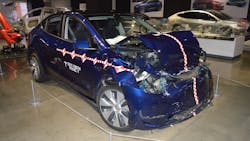It’s no secret the onslaught of EVs that was predicted at the beginning of the decade by some auto manufacturers and public officials hasn’t exactly the electrified revolution they had hoped it would be so far, but that doesn’t mean you shouldn’t be prepared to repair them.
According to data from a 2023 J.D. Power report, EVs still only account for less than 1 percent of all vehicles on U.S. roads today.
“Because only around 17 million new cars are being built each year, changing the vehicles from gas-powered to electric will be a long process, especially as far as the government is concerned,” the report says.
Still, despite the lack of overwhelming adoption, EVs are slowly working their way into the mainstream, and sooner or later they will make up a sizeable chunk of the U.S. car parc. A report from Cox Automotive in October 2023 shows that yearly EV sales were on track to surpass 1 million units for the first time ever.
Electric vehicles will continue to grow in popularity, and although they may not be replacing ICE vehicles anytime soon like some OEMs have said, it won’t be long before you may see some start rolling into your shop’s bays. Because of that, your shops need to have proper procedures in place and your technicians need to know how to deal with the high-voltage systems of electric vehicles to work on them safely and effectively.
Know Before You Stow
Kye Yeung, president of European Motor Car Works in Costa Mesa, California, is an expert in EV repairs. Currently certified to work on Lucid and Rivian, his shop was also one of the original founder shops for Tesla. Safe to say, he and his team know EVs.
For the most part, Yeung says, working on an electric vehicle is very similar to working on an ICE vehicle.
“They have similarities, obviously, as far as the drivetrains, suspensions, brakes; the construction methods are very similar,” Yeung says. “The only thing that's different is the powertrain, and on an EV, properly trained, they're not any more dangerous or difficult to work on than if someone had to rebuild a motor or transmission.”
However, that one difference obviously plays a big role in how a shop goes about the whole repair process, especially following a collision. It’s critical that shops follow OEM protocol when handling EVs that have been damaged in a collision, even before the vehicle is brought into one of your bays.
Most manufacturers recommend that damaged vehicles are kept at least 50 feet away from any structures to assess damage and power down the vehicle. Yeung says that even if an electric vehicle hasn’t caught fire immediately after an accident, there’s still a possibility that it could hours or even days afterward due to the chemicals used in the powertrain and battery.
“The impact from the accident could have dislodged some of the components from the battery pack; it could be festering, and a couple days later it could start to react with itself and cause a fire,” Yeung says. “We always have tow-ins that are really hard hits that look like they may have some extensive damage towed to a specific area until they're able to be checked out.”
Dirk Fuchs, founder and owner of Electric Mobility Consulting and a leading expert in the EV space, shared a story of a dealership garage that left an EV overnight without going through the proper steps to make sure the vehicle was stable. Sure enough, the next morning both the car and the shop were on fire.
"That was a manufacturer dealership. You can't bring in a car with a major battery failure without isolating that vehicle and processing that vehicle,” Fuchs says. “If it takes you an hour and a half to take that battery out, you take the hour and a half before going home so that the car and your shop are still there the next morning.”
Yeung says it’s crucial to follow OEM standard operating procedures on all repairs as soon as your shop gets a call about an EV that’s been in a collision.
“In a nutshell, working on an EV is not dangerous if you follow the manufacturer's guidelines and procedures,” he says. “You always want to follow their latest updates because they can change. Following instructions is the safety rule of thumb.”
Stick to What You Know
Making sure an electric vehicle is safe to be in your shop is just the first step in the repair process.
“Before starting the repair, your technicians need to know and understand what the risks are so they can mitigate those risks,” Fuchs says. “They need to understand the architecture of the vehicle so they know what tools to use.”
While there are very solid aftermarket tools used for scanning and other EV repair procedures, Yeung advises using OEM tools whenever possible for liability purposes. Making sure your techs follow every repair procedure to the letter and are using the recommended tools at all times will help ensure that a repair is done correctly.
“If you're a long-established shop, you're that way for a reason. Don't deviate from a repair plan. If it's in writing somewhere, it's available to you, and if you decide to circumvent that, liability can rise.”
Yeung also says at this point in time, it’s practically impossible for shops to acquire every piece of equipment necessary to repair every EV. Instead, gaining a certification in the brand or couple of brands that your shop works the most on is the best way to go, maximizing your tech’s training time and your shop’s resources.
“If an EV comes in that we're not up to speed on, we'll refer it elsewhere,” he says. “You don't want to be the person doing the R&D in the shop if you've got other work in the shop that you can be more profitable at. We always stick to what we know.”





